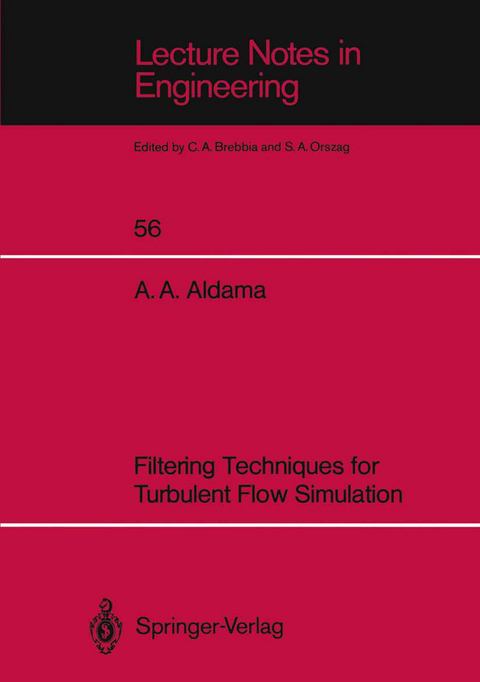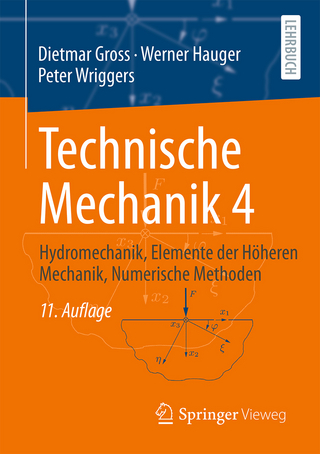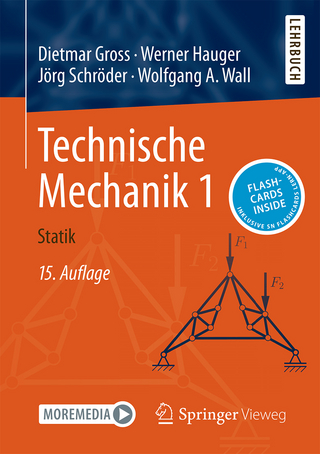
Filtering Techniques for Turbulent Flow Simulation
Springer Berlin (Verlag)
978-3-540-52137-2 (ISBN)
1 Introduction.- 1.1 Scope of the Study.- 1.2 Report Outline.- 2 Turbulence Modeling.- 2.1 The Nature of Turbulent Flows.- 2.2 Conventional Turbulence Modeling.- 2.3 Large Eddy Simulation.- 2.4 Summary.- 3 Two-Scale Filtering Approach Theory.- 3.1 Introduction.- 3.2 Space-Time Filtering Approach.- 3.3 The Leonard Approximation in the STF Context.- 3.4 The Approximation of the Cross Terms.- 3.5 The Asymptotic Nature of the Leonard Approximation.- 3.6 The Asymptotic Nature of the Approximation of the Cross Terms.- 3.7 Fourier Space Theory.- 3.8 Filtering Effect of Discrete Approximations.- 3.9 Closure Model.- 3.10 Summary.- 4 Three-Scale Filtering Approach Theory.- 4.1 Introduction.- 4.2 Three-Scale Approach.- 4.3 Macroscale Dynamics.- 4.4 Mesoscale Dynamics.- 4.5 Relationship between Two- and Three-Scale Approaches.- 4.6 Closure Model.- 4.7 Summary.- 5 Direct Simulations of Periodic Burgers' Flow.- 5.1 Introduction.- 5.2 Burgers' Equation as a Mathematical Model of Turbulence.- 5.3 Shock Development and Energy Equation for Free Burgers' Flow.- 5.4 Design of Numerical Experiment for Free and Periodic Burgers' Flow.- 5.5 Computation of Spectral Statistics.- 5.6 Filtering of Instantaneous Variables.- 5.7 Generation of Initial Conditions.- 5.8 Numerical Scheme.- 5.9 Numerical Stability Analysis.- 5.10 Results for Free and Periodic Burgers' Flow.- 5.11 Forced and Periodic Burgers' Problem.- 5.12 Generation of Random Forcing.- 5.13 Results for Forced and Periodic Burgers' Flow.- 5.14 Summary.- 6 Numerical Experiments with Two-Scale Filtering Approaches Applied to Periodic Burgers' Flow.- 6.1 Introduction.- 6.2 LES Approach for Free Burgers' Flow.- 6.3 STF Approach for Forced Burgers' Flow.- 6.4 Relationship between LES and STF Approaches.- 6.5 NumericalScheme.- 6.6 Simulation of Space-Filtered (LS) Free Burgers' Flow.- 6.7 Simulation of Space-Time Filtered (STF) Forced Burgers' Flow.- 6.8 Summary.- 7 Numerical Experiments with Three-Scale Filtering Approach Applied to Periodic Burgers' Flow.- 7.1 Introduction.- 7.2 Space-Filtered Macroscale Dynamics.- 7.3 Space-Filtered Mesoscale Dynamics.- 7.4 Numerical Scheme.- 7.5 Simulation of Space-Filtered (Free) Mesoscale Burgers' Flow.- 7.6 Summary.- 8 Discussion, Conclusion and Recommendations.- 8.1 Conventional Averaging Procedures Versus Filtering.- 8.2 Discussion of Results and Summary of Contributions.- 8.3 Recommendations for Future Research.- Appendix A Implicit Factored - Quadratic Finite Element Formulation of Stf Forced Burgers' Equation.- Appendix B Implicit Factored - Quadratic Finite Element Formulation of Les-Mesoscale Equation.- References.
| Erscheint lt. Verlag | 16.1.1990 |
|---|---|
| Reihe/Serie | Lecture Notes in Engineering |
| Zusatzinfo | VIII, 397 p. 3 illus. |
| Verlagsort | Berlin |
| Sprache | englisch |
| Maße | 170 x 242 mm |
| Gewicht | 701 g |
| Themenwelt | Naturwissenschaften ► Physik / Astronomie ► Mechanik |
| Technik ► Maschinenbau | |
| Schlagworte | Calculus • Design • Development • fluid- and aerodynamics • Fluid Dynamics • Large Eddy Simulation • Model • Modeling • Navier-Stokes Equation • Navier-Stokes-Gleichungen • Numerical Methods • numerische Simlation • partial differential equation • Raum-Zeit-Filtern • Simulation • Statistics • Turbulenz |
| ISBN-10 | 3-540-52137-2 / 3540521372 |
| ISBN-13 | 978-3-540-52137-2 / 9783540521372 |
| Zustand | Neuware |
| Informationen gemäß Produktsicherheitsverordnung (GPSR) | |
| Haben Sie eine Frage zum Produkt? |
aus dem Bereich


